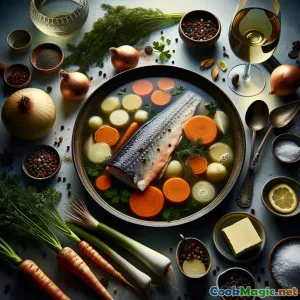
Рустикальный баварский бульон с зимними корнями
(Rustic Bavarian Char Broth with Winter Roots)
(0 Обзоры)0
1,232
июль 15, 2025
Сообщить о проблеме
Ингредиенты
-
500 grams Филе арктической форели
(Без кожи, без костей, нарезанное кубиками по 3 см)
-
2 medium Морковь
(Очистить и нарезать кубиками)
-
2 medium Пастернак
(Очистить и нарезать кубиками)
-
1/2 medium Сельдерей корень (корень сельдерея)
(Кубиками)
-
1 large Лук-порей
(Очистлено и тонко нарезано)
-
2 small Картофель
(Тип восковой, очищенный и нарезанный кубиками)
-
1 medium Лук
(Мелко нарезанный)
-
100 ml сухое белое вино
(По желанию для усиления вкуса)
-
1 liter Рыбный бульон
(Идеально домашний или с низким содержанием натрия)
-
2 tbsp Свежая петрушка
(Мелко нарезанный, для украшения)
-
1 whole Лавровый лист
-
3 whole ягоды можжевельника
(Легко раздавленный)
-
5 whole Целые черные перцовые горошины
-
2 tbsp Масло
(для обжарки овощей)
-
1 tsp Цедра лимона
(Свеженатертый)
-
to taste Морская соль
-
to taste Свежемолотый черный перец
(Без кожи, без костей, нарезанное кубиками по 3 см)
(Очистить и нарезать кубиками)
(Очистить и нарезать кубиками)
(Кубиками)
(Очистлено и тонко нарезано)
(Тип восковой, очищенный и нарезанный кубиками)
(Мелко нарезанный)
(По желанию для усиления вкуса)
(Идеально домашний или с низким содержанием натрия)
(Мелко нарезанный, для украшения)
(Легко раздавленный)
(для обжарки овощей)
(Свеженатертый)
Питательная ценность
- Порции: 4
- Размер порции: 1 миска (300мл)
- Calories: 310 kcal
- Carbohydrates: 0 g
- Protein: 27 g
- Fat: 10 g
- Fiber: 5 g
- Sugar: 7 g
- Sodium: 760 mg
- Cholesterol: 55 mg
- Calcium: 72 mg
- Iron: 1.8 mg
Инструкции
-
1 - Подготовка овощей и рыбы:
Нарежьте морковь, пастернак, сельдерей и картофель на маленькие равные кубики. Нарежьте лук-порей тонкими ломтиками и мелко порубите лук. Нарежьте филе арктической форели кубиками по 3 см и промокните насухо. отложите в сторону.
-
2 - Обжаривание Ароматов:
В большой голландской печи или суповой кастрюле растопите масло на среднем огне. Добавьте лук и порей; пассеруйте до прозрачности, но не до золотистого цвета. Вмешайте морковь, пастернак, сельдерей и картофель. Продолжайте пассеровать еще 5 минут.
-
3 - Деглазировать и приправить:
Влейте белое вино (если используете) и используйте деревянную ложку, чтобы соскрести коричневые кусочки со дна. Пусть вино уварится 2 минуты. Добавьте лавровый лист, измельчённые ягоды можжевельника (если используете) и перец.
-
4 - Тушите бульон:
Добавьте рыбный бульон. Доведите до мягкого кипения, затем уменьшите огонь до минимума. Готовьте, наполовину накрытым, 20–25 минут или до мягкости корнеплодов.
-
5 - Тушение арктического лосося:
Аккуратно добавьте кубики арктической форели в кипящий бульон. Тушите нежно в течение 5–6 минут, пока рыба не будет готова и легко распадается на flakes, но останется влажной.
-
6 - Завершить и подать:
Удалите лавровый лист и ягоды можжевельника. Приправьте бульон солью и свежемолотым черным перцем по вкусу. Разлейте бульон и рыбу по мискам. Украсьте свежей петрушкой и цедрой лимона непосредственно перед подачей.
Нарежьте морковь, пастернак, сельдерей и картофель на маленькие равные кубики. Нарежьте лук-порей тонкими ломтиками и мелко порубите лук. Нарежьте филе арктической форели кубиками по 3 см и промокните насухо. отложите в сторону.
В большой голландской печи или суповой кастрюле растопите масло на среднем огне. Добавьте лук и порей; пассеруйте до прозрачности, но не до золотистого цвета. Вмешайте морковь, пастернак, сельдерей и картофель. Продолжайте пассеровать еще 5 минут.
Влейте белое вино (если используете) и используйте деревянную ложку, чтобы соскрести коричневые кусочки со дна. Пусть вино уварится 2 минуты. Добавьте лавровый лист, измельчённые ягоды можжевельника (если используете) и перец.
Добавьте рыбный бульон. Доведите до мягкого кипения, затем уменьшите огонь до минимума. Готовьте, наполовину накрытым, 20–25 минут или до мягкости корнеплодов.
Аккуратно добавьте кубики арктической форели в кипящий бульон. Тушите нежно в течение 5–6 минут, пока рыба не будет готова и легко распадается на flakes, но останется влажной.
Удалите лавровый лист и ягоды можжевельника. Приправьте бульон солью и свежемолотым черным перцем по вкусу. Разлейте бульон и рыбу по мискам. Украсьте свежей петрушкой и цедрой лимона непосредственно перед подачей.
Подробнее о: Рустикальный баварский бульон с зимними корнями
Bavarian Char Broth with Root Vegetables: Story, Culture & Chef’s Notes
Bavaria—the emblem of southern Germany—may be best known for its breezy mountain landscapes, hearty Oktoberfest fare, and world-class breads. Yet, Bavaria is also a region where crystal-clear lakes meet alpine agriculture, inspiring some of Europe’s most honest, earthy soups. Among them, fish broths hold a timeless place, linking local fishmongers, mountain farmers, and village cooks who invented ways to elevate humble roots and lakeside bounty. Bavarian Char Broth with Root Vegetables seeks to channel those farmhouse traditions in a bowl.
History and Cultural Significance
The concept of turning lake fish into broth hails from rural necessity. In lakeshores like Chiemsee, char, trout, and pike were caught early and often. Root vegetables, perfectly suited for Bavaria's cool climate and rocky soil, could be stored through harsh winters. Home cooks developed broths to capture the essence of both—meals that were nourishing and restorative through winter, but elegant enough for a Sunday table.
While char is most notably fished in the icy lakes of the Alps, it has become symbolic of regional pride. The aromatic root blend mirrors the age-old customs that honored subtle sweetness and gentle earthiness. Traditionally, such broths ("Fischsuppe" or more specifically, "Saiblingseintopf" for char) were communal, served to warm hands and spirits alike.
Unique Aspects and Personal Chef Insights
• Char Flavor: Arctic char brings a luxurious, buttery flavor somewhere between trout and salmon, but a leaner texture and delicate flake ideal for broths—it never overpowers the roots and aromatics. • Root-Rich Base: Carrots, parsnips, celeriac, and potato create natural sweetness and depth, while leek and onion add a savory foundation. Celeriac in particular is a regional favorite, giving an unmistakable "Old World" note. • Juniper, Bay, and Wine Touches: A whisper of crushed juniper and dry white wine (a nod to the region's vineyards and forests) weaves complexity without crowding the palate. • Lemon Zest & Parsley: These finishing touches, though seemingly simple, are traditional methods to freshen up the deep flavors just before serving. They add brightness—and a hint of spring even in mid-winter.
Cooking Tips & Best Practices
- Stock Selection: Choose a high-quality, gently seasoned fish stock—homemade is best. A splash of white wine helps break up any fishiness, integrating earthier vegetable flavors flatly and evenly. Vegetable or chicken stock can substitute if needed.
- Poaching Fish: Bring the broth temperature down before poaching the char to ensure the cubes stay succulent and tender. Overcooking will lead to flakiness rather than pleasant firmness.
- Serving Variation: This soup craves a hunk of rustic rye or sourdough bread, and traditionalists might also stir in a handful of fresh garden herbs in the final moments for even more color.
Personal Reflection
As a chef, I find rich nostalgia in recipes like this. You can taste the careful stewardship—nothing wasted, everything celebrated. Today, this Bavarian Char Broth invites us to simmer down and prioritize soulful, wholesome food. The broth’s savory complexity and sparkling fresh finish, paired with the comforting weight of root vegetables, represent both togetherness and tenacity found in Alpine communities. It's an ideal winter lunch, first course, or a light but hearty weekend dinner, particularly when snow lines the trees outside your kitchen window.
Conclusion: Why You Should Try It
Bavarian Char Broth with Root Vegetables is equal parts historical homage and cozy, modern comfort. Every element—fish, root, leaf—contributes symbiotically to something both satisfying and refined. Let this hearty recipe become a new favorite on brisk days, whenever you crave both warmth and a taste of Europe’s lakeside heritage.

























